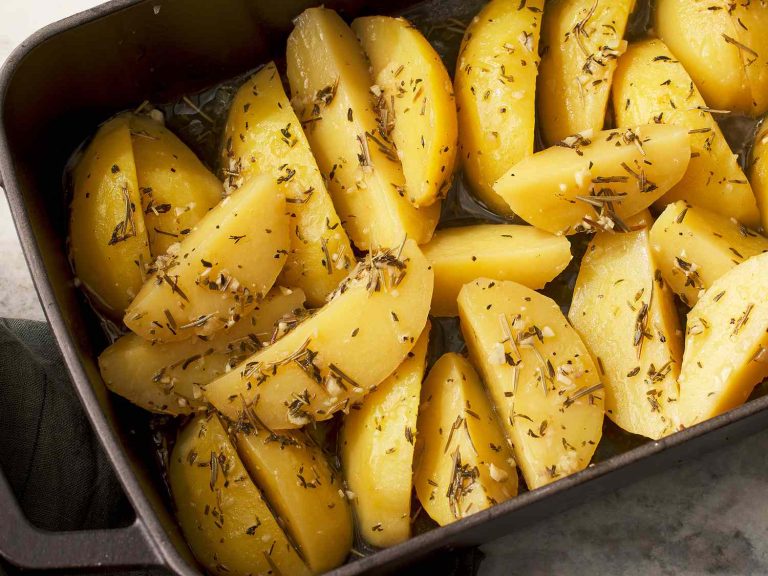Gorgonzola Cheese Sauce: Recipes, Tips, and Storage Solutions
Gorgonzola cheese hails from Italy, specifically the regions of Piedmont and Lombardy. It’s one of the oldest blue-veined cheeses, dating back over a thousand years. This cheese comes in two main varieties: Gorgonzola Dolce (sweet) and Gorgonzola Piccante (spicy). Gorgonzola Dolce has a creamy texture and milder flavor. In contrast, Gorgonzola Piccante presents a firmer texture and stronger taste. Both types use cow’s milk and undergo aging to develop their distinctive characteristics.
Nutritional Values
Gorgonzola cheese offers various nutritional benefits. A 100-gram serving provides approximately:
| Nutrient | Value |
|---|---|
| Calories | 353 kcal |
| Protein | 21.4 grams |
| Fat | 28.3 grams |
| Carbohydrates | 2.3 grams |
| Calcium | 528 mg |
| Sodium | 1,290 mg |
This cheese is rich in calcium and protein, contributing to bone health and muscle repair. However, it contains high levels of fat and sodium, making moderation important.
Making Gorgonzola Cheese Sauce
Essential Ingredients
To create a rich Gorgonzola cheese sauce, gather the following ingredients:
- Heavy Cream (1 cup): Provides a smooth and creamy base.
- Gorgonzola Cheese (4 oz): Choose between Gorgonzola Dolce for a milder flavor or Gorgonzola Piccante for a stronger taste.
- Butter (2 tablespoons): Adds richness and helps with the sauce’s texture.
- Garlic (1 clove, minced): Gives a subtle aromatic flavor.
- White Wine (1/4 cup): Enhances the sauce’s depth.
- Salt (to taste): Balances the flavors.
- Black Pepper (to taste): Adds a hint of spice.
- Parsley (1 tablespoon, chopped): Optional for garnish and a touch of freshness.
Step-by-Step Cooking Guide
Follow these steps to make Gorgonzola cheese sauce:
- Melt Butter: Heat a pan on medium heat and melt the butter.
- Sauté Garlic: Add minced garlic and sauté for 1-2 minutes, making sure it doesn’t brown.
- Add White Wine: Pour in the white wine and let it simmer until it reduces by half.
- Pour Heavy Cream: Add the heavy cream, stirring frequently until it begins to thicken.
- Incorporate Gorgonzola: Reduce the heat to low and add the Gorgonzola cheese. Stir until the cheese melts and the sauce is smooth.
- Season: Add salt and black pepper to taste.
- Garnish: Remove from heat and garnish with chopped parsley if desired.
Your Gorgonzola cheese sauce is now ready to enhance any dish, from pasta to steak.
Uses of Gorgonzola Cheese Sauce
Classic Recipes
Gorgonzola cheese sauce enhances various classic recipes. Drizzle it over pasta dishes like fettuccine or penne to add a rich, creamy element. Pour it on steak to complement the meat’s flavor profile. Use it as a dip for bread, elevating simple starters. Incorporate it into risotto recipes for a decadent twist.
Innovative Culinary Ideas
Experiment with innovative culinary ideas using Gorgonzola cheese sauce. Combine it with roasted vegetables, such as Brussels sprouts or cauliflower, for a gourmet side dish. Use it as a pizza base sauce, replacing traditional tomato sauce to create a unique, flavorful pizza. Add it to a baked potato instead of regular toppings like butter or sour cream. Drizzle it over grilled chicken to elevate a simple protein. Try mixing it into mashed potatoes for an indulgent, velvety texture.
Pairing Suggestions
Wines and Beverages
Pairing Gorgonzola cheese sauce with the right wine can enhance your dining experience. Choose robust red wines, such as Cabernet Sauvignon and Merlot. These wines balance the rich and creamy sauce. For white wine lovers, go for Chardonnay or Sauvignon Blanc. These wines provide a refreshing contrast. Sparkling wines like Prosecco can also complement the sauce by cleansing your palate. Beer enthusiasts can enjoy Belgian Ales or IPAs, offering a hoppy bitterness to counter the sauce’s richness. Non-alcoholic choices like apple cider or sparkling water with a slice of lemon make great alternatives.
Other Foods
Gorgonzola cheese sauce works incredibly well with various foods. Drizzle it over roasted vegetables, such as Brussels sprouts, carrots, and bell peppers, for an extra layer of flavor. Incorporate it into mashed potatoes to create an indulgently creamy side dish. Use it as a base for pizza, enhancing toppings like mushrooms, spinach, or even pears. Enhance grilled meats such as steaks, pork chops, and chicken breasts by adding a generous amount of the sauce on top. Mix it into risotto dishes for a luxurious touch. Finally, serve it with baked potatoes, providing a rich and tangy addition to the classic comfort food.
Storing and Preserving Gorgonzola Cheese Sauce
Shelf Life
Gorgonzola cheese sauce lasts typically 4 to 7 days when refrigerated at 40°F. To guarantee freshness, use a clean, airtight container. Label the container with the preparation date to track the sauce’s age. Discard the sauce if it develops an odd smell or mold.
Best Practices
Cool the sauce completely before storing it. Place it in airtight containers to prevent air exposure, which can alter the flavor. Keep it on the refrigerator’s bottom shelf, where the temperature is most consistent. Reheat only the amount you plan to use, as repeated heating can degrade the sauce’s quality. For longer storage, freeze the sauce in small portions for up to three months, using freezer-safe containers. Thaw frozen sauce in the refrigerator before reheating to ensure even consistency.
Conclusion
Gorgonzola cheese sauce is a versatile addition to your culinary repertoire. Its rich, creamy texture and distinct flavor elevate any dish, from pasta to steak. With proper storage, you can enjoy its deliciousness for days. Experiment with different pairings and savor the unique taste that Gorgonzola brings to your meals.






